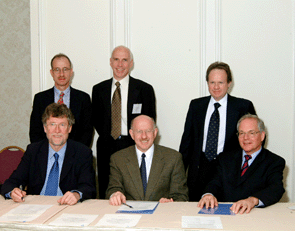URL: https://www.desy.de/information__services/press/press_releases/2002/pr_011102/index_eng.html
Breadcrumb Navigation
X-Ray Laser Cooperation within the scope of the TESLA-Project
With the signature of a Memorandum of Understanding on November 1, in Washington, both major accelerator centers–DESY (the German Electron Synchrotron) in Hamburg, Germany, and SLAC (Stanford Linear Accelerator Center) in California, USA–set the seal on their intention to start a close collaboration in X-ray laser research and to make joint efforts to promote this trend-setting field of research. Professor Dr. Albrecht Wagner, Chairman of the DESY Board of Directors and one of the three signatories of the Memorandum stated that "free-electron lasers for X-ray radiation offer revolutionary chances for the investigation of the microcosm, and the present agreement for intensive German-American co-operation guarantees an optimal further development of and benefit from these new light sources for science."
The Memorandum of Understanding between DESY and SLAC establishes a "Collaborative Research Effort to Enable the Exploitation of the Scientific Capabilities of the Linac Coherent Light Source (SLAC project LCLS) and the TESLA X-Ray Free-Electron Laser" (DESY project TESLA-XFEL). The Memorandum was signed last Friday in the Department of Energy (DOE) in Washington. Among others, the Memorandum describes the exchange of personnel, equipment, research results and data, as well as know-how. This will accelerate and contribute to the scientific programs of both facilities, which complement one another in their qualities and, according to current planning, will start operation in 2008 and 2011 respectively. The first step will be the joint benefit from the research results from each of the small pilot facilities which are already under construction in Stanford and Hamburg. "X-ray lasers are a great challenge for the future!" said Professor Dr. Jochen R. Schneider, DESY Research Director and co-signatory of the Memorandum. "Both facilities offer pioneering research possibilities, exceeding by far the potential of present-day radiation sources."
DESY and SLAC are world leading laboratories in the development and operation of electron accelerators for basic research in elementary particle physics as well as for numerous investigations in physics, biology, material sciences and chemistry, making use of electromagnetic radiation produced on these accelerators. The next step on the way to more powerful light sources are the so called free-electron lasers (FEL). They produce laser-like X-ray radiation with an ultra-short wave length and very high peak brilliance. In the past years, DESY and SLAC made key contributions for the development of a free-electron X-ray laser. Today, experts worldwide are convinced of the technological feasibility of this new generation of research instruments.–"International collaboration is the most efficient way of building world-class science facilities. There is already dynamic collaboration between SLAC, DESY and the KEK laboratory in Japan on research and development for a future particle physics linear collider. Today’s agreement establishes stronger bonds between international centers of excellence." said Professor Dr. Jonathan Dorfan, Director of SLAC, who also signed the Memorandum.
For the TESLA project, parallel to the planned 33-kilometer long accelerator for elementary particle physics, DESY proposes to build a linear accelerator for FEL-X-ray laser (TESLA-XFEL). They can generate extremely short and intense X-ray flashes with laser properties. At peak values, their brilliance is a billion times higher than that of modern X-ray sources; time resolution is one thousand times as high. The flash duration is less than one million millionth of a second, and the wavelength of the flashes is so small that even atomic details become discernible–the wavelength can be varied in the range of one to one tenth of a nanometer. These inconceivably brief X-ray pulses enable researchers to record what are essentially films from the microscopic world, to monitor, for example, how a chemical reaction progresses, how solids are formed or to learn more about what occurs in living cells.–The TESLA project is currently evaluated by the German Scientific Council, on assignment of the Federal Government, together with seven other planned German scientific projects. On the basis of the recommendation, the final TESLA decision can be expected in 2003.

Signatories of the Memorandum, left to right: Professor Albrecht Wagner, Professor Jonathan Dorfan, Professor Jochen R. Schneider;
back row, left to right: Dr. Jerry Hastings, Project Manager of the SPPS Experiment, Dr. John Galayda, Director of LCLS project, Professor Keith Hodgson, Director of SSRL.
(Picture: Department of Energy, DOE)


